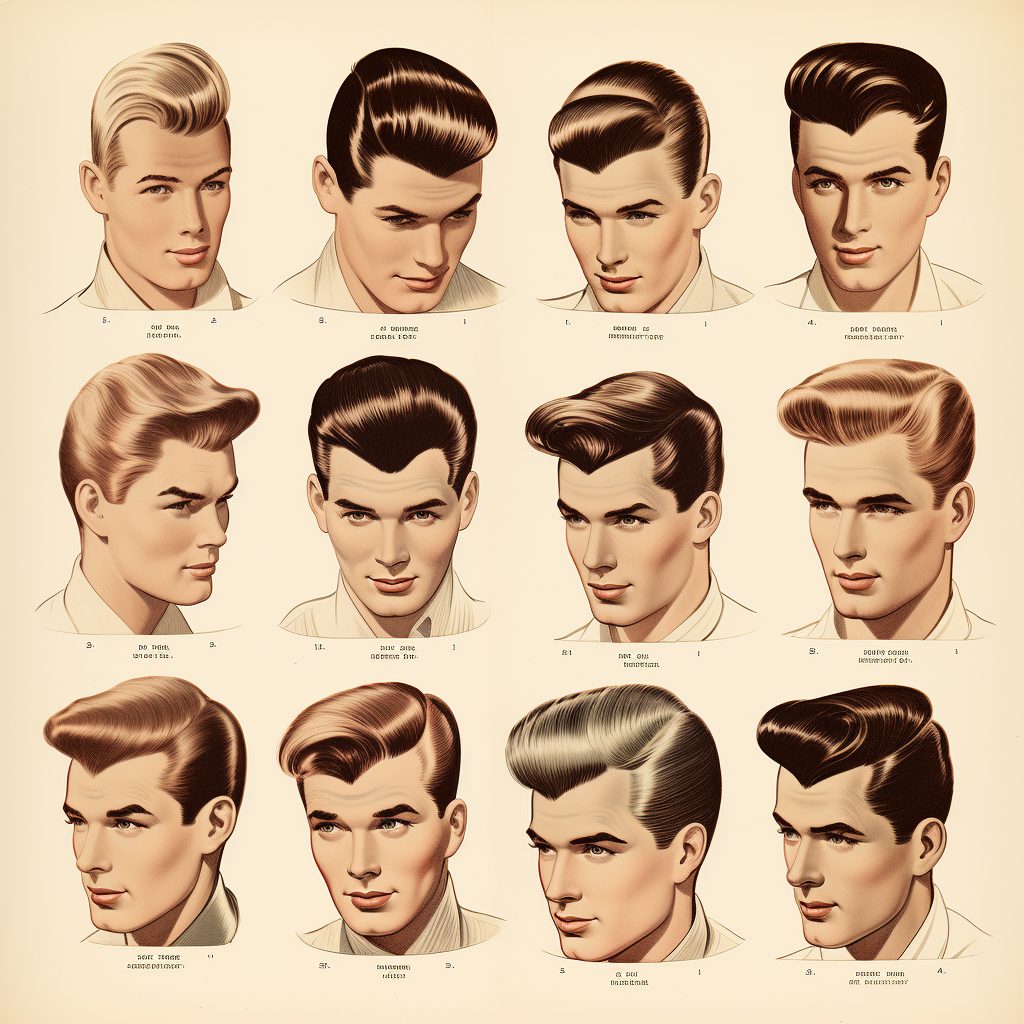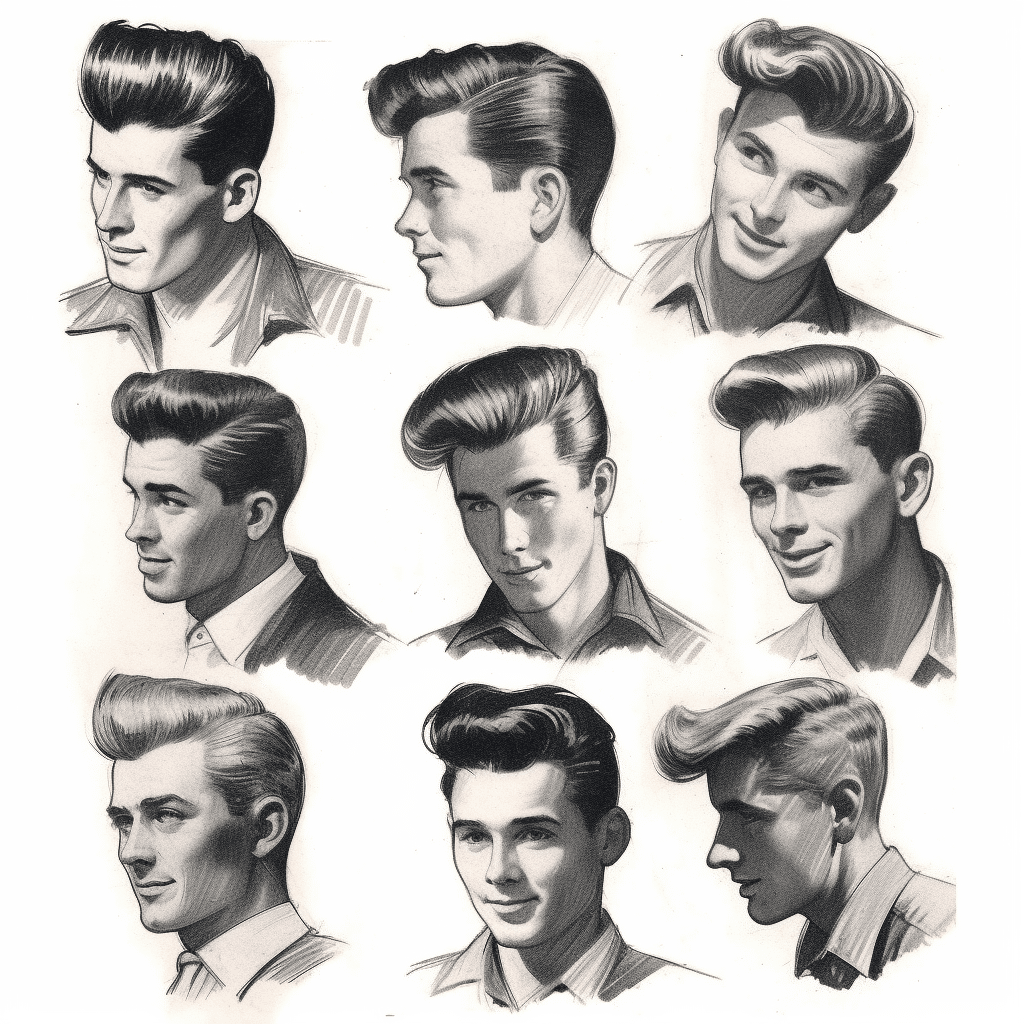
The 1950s, a decade often romanticized as a golden age of prosperity and optimism, left an indelible mark on the world of fashion and beauty. Emerging from the austerity of World War II, the era embraced a return to glamour, femininity, and a distinctly structured aesthetic. This period saw the solidification of the "American Dream" ideal, influencing everything from domestic life to the meticulously curated wardrobes and coiffures of men and women alike. Fueled by economic growth, the rise of suburban living, and the pervasive influence of Hollywood and television, 1950s fashion and hairstyles became synonymous with elegance, conformity, and a subtle undercurrent of burgeoning rebellion.
The Dawn of the New Look: Redefining Femininity
The foundational influence on 1950s women’s fashion was undoubtedly Christian Dior’s "New Look," unveiled in 1947. This revolutionary silhouette dramatically departed from the boxy, utilitarian styles necessitated by wartime rationing. Dior’s vision celebrated an exaggerated hourglass figure: rounded shoulders, a dramatically cinched waist, a full bust, and voluminous, often calf-length skirts. This opulent, fabric-intensive style, initially met with mixed reactions due to its perceived extravagance, quickly became the aspirational standard for post-war femininity.
The New Look permeated all levels of fashion, from haute couture to ready-to-wear, establishing the key elements that would define the decade. Women embraced structured undergarments, including girdles and bullet bras, to achieve the desired silhouette, and petticoats or crinolines were essential for creating the characteristic full skirt. This emphasis on a meticulously constructed appearance underscored a societal shift towards a more idealized, polished image of womanhood, often centered around domesticity and refined social graces.
Women’s Fashion: From Daywear to Dazzling Evenings
The 1950s offered women a diverse range of styles, each meticulously designed to project an image of effortless elegance, even in casual settings.
Daywear Silhouettes:
While the full skirt remained dominant, two primary silhouettes defined daywear:
- The Full Skirt (A-line or Circle Skirt): This was the quintessential 1950s look. Dresses and skirts flared out dramatically from a nipped-in waist, often supported by multiple layers of stiff netting or crinoline. Shirtwaist dresses, featuring a button-down bodice reminiscent of a man’s shirt and a full skirt, were incredibly popular for their practicality and classic appeal. Fabrics ranged from crisp cottons and ginghams for casual wear to wools and sophisticated synthetics like Dacron for more formal daytime ensembles. Patterns like polka dots, florals, plaids, and vibrant solids were common.
- The Pencil Skirt/Sheath Dress: Offering a sleek, sophisticated alternative, the pencil skirt was narrow and straight, typically ending just below the knee. Paired with a fitted blouse or a tailored jacket, it created a sharp, professional look. Sheath dresses followed the contours of the body, providing a streamlined and elegant silhouette, often favored for office wear or more formal daytime events. Tailored suits, featuring fitted jackets and either full or pencil skirts, were also a staple for the professional woman.
Separates and Casual Wear:
Separates gained popularity, allowing women to mix and match. Fitted blouses, often with Peter Pan collars or delicate embroidery, were paired with skirts. Twin sets (matching cardigans and pullovers) became a preppy staple. For more casual occasions, capri pants, pedal pushers, and high-waisted shorts emerged, often worn with fitted tops or simple blouses. These casual styles, while still modest, hinted at a growing desire for comfort and ease, especially for leisure activities.
Accessories:
Accessories were paramount to completing the 1950s look. Gloves were almost universally worn for daytime outings, ranging from short wrist-length styles to elegant opera-length gloves for evening. Hats, though declining in everyday use towards the end of the decade, were still significant, with pillbox hats, cloches, and wide-brimmed styles being popular. Pearls, often in multiple strands, and costume jewelry were favored. Small, structured handbags, often with short handles, were the norm. Footwear consisted primarily of pointed-toe pumps, kitten heels, and slingbacks, designed to complement the refined aesthetic.
Evening Wear and Special Occasions:
Evening wear in the 1950s was the epitome of glamour. Ball gowns were grand and voluminous, crafted from luxurious fabrics like satin, taffeta, and lace, often featuring intricate embellishments. Cocktail dresses, typically shorter than ball gowns but still highly elaborate, were perfect for semi-formal gatherings. These dresses often featured rich textures, sequins, beads, and dramatic necklines. Stoles, wraps, and opera gloves completed these opulent ensembles, allowing women to truly dazzle.
Women’s Hairstyles: Sculpted Perfection
Just as fashion emphasized structure and polish, 1950s hairstyles for women were meticulously styled, often requiring significant effort and product. The overall trend was neat, sculpted, and feminine, with curls and waves being dominant features.
- The Bouffant: This voluminous style, achieved by backcombing or teasing the hair at the crown, created a soft, rounded shape. It was often swept back from the face or styled with a slight side part, exuding sophistication and elegance.
- The Poodle Cut: Popularized by Lucille Ball, this short, tightly curled style was practical yet playful. It involved setting the hair in small rollers to create a mass of bouncy curls that framed the face.
- The Pageboy: A classic and enduring style, the pageboy featured smooth, rounded ends that curled inwards, often paired with soft bangs. It was a neat, polished look that suited various hair lengths.
- The Beehive (Late 50s/Early 60s Precursor): While truly peaking in the early 1960s, the beehive began to emerge in the late 1950s, signaling a move towards even more dramatic volume and height, often achieved with significant backcombing and hairspray.
- The Ponytail: For more casual settings, the ponytail became a popular choice, often worn high on the crown and sometimes tied with a silk scarf or ribbon, adding a touch of youthful charm.
- Victory Rolls (Lingering Influence): While a signature of the 1940s, victory rolls (hair rolled up and away from the face) still saw some use, particularly in transitional styles or for specific retro looks.
Hair products like setting lotions, hairnets, and the newly popular hairspray were essential for maintaining these structured styles. Rollers, bobby pins, and styling combs were standard tools in every woman’s beauty arsenal. Hair accessories included scarves (worn tied under the chin or as headbands), decorative clips, and small fascinators.
Men’s Fashion: From Conformity to Rebellion
Men’s fashion in the 1950s reflected a similar dichotomy between conservative elegance and emerging youth rebellion.
Conservative & Tailored:
For the average man, the suit remained the cornerstone of his wardrobe. Single-breasted suits with wider shoulders and narrower lapels were common, often in subdued colors like grey, navy, and brown. White shirts, often with crisp collars, and ties were standard. Fedoras were the quintessential headwear, completing the formal look. This style projected an image of stability, responsibility, and professionalism.
Casual Wear and Youth Subcultures:
The post-war era also saw the rise of distinct casual wear and youth subcultures that challenged traditional norms.
- The Ivy League Look: Popular among college students, this style was neat, preppy, and understated. It featured button-down shirts, chinos, V-neck sweaters, tweed jackets, and loafers. It was a more relaxed yet still polished alternative to the formal suit.
- The Greaser/Rebel Look: Heavily influenced by icons like Marlon Brando and James Dean, this style embodied rebellion and coolness. It consisted of leather jackets, denim jeans (Levi’s became iconic), white T-shirts, and sturdy boots. This look was raw, rugged, and deliberately defied the polished image of the mainstream.
- Leisure Wear: For leisure activities, men embraced bowling shirts, Hawaiian shirts (especially after soldiers returned from the Pacific), and casual knitwear.
Men’s Hairstyles:
Men’s hairstyles were equally varied, reflecting their social standing or subcultural affiliation.
- Slicked Back: The pompadour, popularized by Elvis Presley, involved sweeping the hair up and back from the forehead, often with significant volume, and slicking the sides. The "Ducktail" or "DA" (Duck’s Ass) was another popular variation, where the hair was combed back on the sides to meet in the middle, resembling a duck’s tail. These styles were achieved with generous amounts of pomade or brilliantine.
- Crew Cut: For a more conservative and clean-cut look, the crew cut was short, neat, and easy to maintain, favored by military personnel and many mainstream men.
- Side Part: A classic and timeless style, the side part involved neatly combing the hair to one side, often with a slight wave or curl, projecting a well-groomed and respectable image.
Children’s Fashion: Miniature Echoes
Children’s fashion in the 1950s largely mirrored adult styles. Girls wore full-skirted dresses with crinolines, often in bright colors or playful patterns, resembling miniature versions of their mothers’ outfits. Boys typically wore shorts or trousers with button-down shirts, sometimes even miniature suits for formal occasions, reflecting the desire for a well-put-together family image.
Cultural Influences and Icons
The 1950s was an era shaped by powerful cultural forces. Hollywood stars were the ultimate style arbiters: Marilyn Monroe’s hourglass figure and bombshell curls, Audrey Hepburn’s elegant gamine look, Grace Kelly’s refined sophistication, and Elizabeth Taylor’s glamorous allure set trends for women. For men, Elvis Presley’s rebellious pompadour and leather jackets, and James Dean’s brooding cool in denim, redefined masculinity. Television sitcoms like "Leave It to Beaver" and "Father Knows Best" presented idealized images of American family life, further reinforcing mainstream fashion norms. The rise of rock and roll music also played a significant role, providing a soundtrack for the youth rebellion that would fully blossom in the following decade.
Conclusion
The 1950s stands as a pivotal decade in fashion history, a bridge between post-war recovery and the social upheavals of the 1960s. It was a time of deliberate elegance, structured silhouettes, and meticulous grooming, reflecting a societal desire for order, prosperity, and a return to traditional values. From Dior’s "New Look" to the iconic hairstyles that defined an era, 1950s fashion and hairstyles celebrated a distinct vision of femininity and masculinity. While conformity was a dominant theme, the subtle emergence of rebellious styles in youth culture hinted at the sartorial revolutions to come. The enduring appeal of 1950s style lies in its timeless glamour, its meticulous attention to detail, and its powerful evocation of a truly iconic era.






